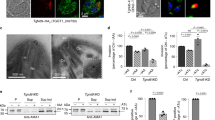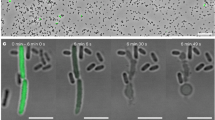Abstract
We have expressed useful amounts of three recombinant proteins in a new eukaryotic host/vector system. The cellular slime mold Dictyostelium discoideum efficiently secreted two recombinant products, a soluble form of the normally cell surface associated D. discoideum glycoprotein (PsA) and the heterologous protein glutathione-S-transferase (GST) from Schistosoma japonicum, while the enzyme β-glucuronidase (GUS) from Escherichia coli was cell associated. Up to 20mg/l of recombinant PsA and 1mg/l of GST were obtained after purification from a standard, peptone based growth medium. The secretion signal peptide was correctly cleaved from the recombinant GST- and PsA-proteins and the expression of recombinant PsA was shown to be stable for at least one hundred generations in the absence of selection.
This is a preview of subscription content, access via your institution
Access options
Subscribe to this journal
Receive 12 print issues and online access
$209.00 per year
only $17.42 per issue
Buy this article
- Purchase on Springer Link
- Instant access to full article PDF
Prices may be subject to local taxes which are calculated during checkout
Similar content being viewed by others
References
Sussman, M. 1987. Cultivation and synchronous morphogenesis of Dictyostelium under controlled experimental conditions. Methods Cell Biol. 28: 9–29.
Zhou-Chou, T., Gooley, A.A., Slade, M.B., Bowers, V.M. and Williams, K.L. 1990. Purification of a membrane glycoprotein with an inositol-containing phospholipid anchor from Dictyostelium discoideum. J. Biotech. 16: 133–144.
Glenn, D. and Williams, K.L. 1988. Dictyostelium discoideum: its future in biotechnology. Aust. J. Biotech. 1: 46–51.
Mierendorf, R.C., Cardelli, J.A. and Dimond, R.L. 1985. Pathways involved in targeting and secretion of a lysosomal enzyme in Dictyostelium discoideum. J. Cell Biol. 100: 1777–1787.
Dingermann, T., Troidl, E.M., Broker, M. and Nerke, K. 1991. Expression of human antithrombin-III in the cellular slime mould Dictyostelium discoideum. Appl. Microbiol. Biotechnol. 35: 496–503.
Fasel, N., Begdadirais, C., Bernard, M., Bron, C., Corradin, G. and Reymond, C.D. 1992. Dictyostelium discoideum as an expression host for the circumsporozoite protein of Plasmodium falciparum. Gene 111: 157–163.
Slade, M.B., Chang, A.C.M. and Williams, K.L. 1991. Improved plasmid vectors for the cellular slime moulds of the genus Dictyostelium. PCT Patent Application No. PCT/AU90/00530, publication No. WO 91/06644.
Chang, A.C.M., Slade, M.B. and Williams, K.L. 1990. Identification of the origin of replication ot the eukaryote Dictyostelium discoideum nuclear plasmid Ddp2. Plasmid 24: 208–217.
Slade, M.B., Chang, A.C.M. and Williams, K.L. 1990. The sequence and organisation of Ddp2, a high-copy-number nuclear plasmid of Dictyostelium discoideum. Plasmid 24: 195–207.
Knecht, D.A., Cohen, S.M., Loomis, W.F. and Lodish, H.F. 1986. Developmental regulation of Dictyostelium discoideum actin gene fusions carried on low-copy and high-copy transformation vectors. Mol. Cell. Biol. 6: 3973–3983.
Leiting, B., Lindner, I.J. and Noegel, A.A. 1990. The extrachromosomal replication of Dictyostelium plasmid Ddp2 requires a cis-acting element and a Plasmid-encoded trans-acting factor. Mol. Cell. Biol. 10: 3727–3736.
Krefft, M., Voet, L., Mairhofer, H. and Williams, K.L. 1983. Analysis of proportion regulation in slugs of Dictyostelium discoideum using monoclonal antibody and FACS-IV. Exp. Cell Res. 147: 235–239.
Haynes, P.A., Gooley, A.A., Ferguson, M.A.J., Redmond, J.W. and Williams, K.L. 1993. Post-translational modification of the Dictyostelium discoideum glycoprotein PsA: Glycosylphosphatidylinositol membrane anchor and composition of O-linked oligosaccharides. Eur. J. Biochem. 216: 729–737.
Early, A.E., Williams, J.G., Meyer, H.E., Por, S.B., Smith, E., Williams, K.L. and Gooley, A.A. 1988. Structural characterisation of Dictyostelium discoideum prespore-specific gene D19 and of its product, cell surface glycoprotein PsA. Mol. Cell. Biol. 8: 3458–3466.
Smith, D.B. and Johnson, K.S. 1988. Single-step purification of polypeptides expressed in Escherichia coli as fusion with glutathione-S-transferase. Gene 67: 31–40.
Jefferson, R.A., Kavanagh, T.A. and Bevan, M.W. 1987. GUS fusions: β-glucuronidase as a sensitive and versatile gene fusion marker in higher plants. EMBO J. 6: 3901–3907.
Jefferson, R.A., Burgess, S.M. and Hirsh, D. 1986. β-Glucuronidase from Escherichia coli as a gene-fusion marker. Proc. Natl. Acad. Sci. USA 83: 8447–8451.
Simons, P.C. and Vander Jagt, D.L. 1981. Purification of glutathione-S-transferases by glutathione-affinity-chromatography. Meth. Enzymol. 77: 235–237.
Slade, M.B. and Williams, K.L. 1989. Recombinant proteins—the costs of production in D. discoideum. Proc. 8th Annual Aust. Biotech. Conf., Sydney.
Kimmel, A.R. and Firtel, R.A. 1982. The organisation and expression of the Dictyostelium genome, p. 233–324. In: The Development of Dictyostelium discoideum. Loomis, W. F. (Ed.). Academic Press, New York.
Davies, A.H., Jowett, J.B.M. and Jones, I.M. 1993. Recombinant Baculovirus vectors expressing glutathione-S-transferase fusion proteins. Bio/Technology 11: 933–936.
Sharp, P.M. and Devine, M. 1989. Codon usage and gene expression level in Dictyostelium discoideum: highly expressed genes do ‘prefer’ optimal codons. Nucl. Acids Res. 17: 5029–5039.
Makoff, A.J., Oxer, M.D., Romanos, M.A., Fairweather, N.F. and Ballantine, S. 1989. Expression of tetanus toxin fragment C in E. coli: high level expression by removing rare codons. Nucl. Acids Res. 17: 10191–10202.
Kotula, L. and Curtis, P.J. 1992. Evaluation of foreign gene codon optimization in yeast: Expression of a mouse IG kappa chain. Bio/Technology 9: 1386–1389.
Hoekema, A., Kastelein, R.A., Vasser, M. and de Boer, H.A. 1987. Codon replacement in the PGK1 gene of Saccharomyces cerevisiae: Experimental approach to study the role of biased codon usage in gene expression. Mol. Cell. Biol. 7: 2914–2924.
Gooley, A.A., Marschalek, R. and Williams, K.L. 1992. Size polymorphisms due to changes in the number of O-glycosylated tandem repeats in the Dictyostelium discoideum glycoprotein PsA. Genetics 130: 749–756.
Freeze, H.H. 1992. Developmental glycobiology of Dictyostelium discoideum, p. 285–317. In: Cell surface carbohydrates and cell development. Fukuda, M. (Ed.). CRC Press, Boca Raton, FL.
Kessin, R.H., Williams, K.L. and Newell, P.C. 1974. Linkage analysis in Dictyostelium discoideum using temperature-sensitive growth mutants selected with bromodeoxyuridine. J. Bact. 119: 776–783.
Fisher, P.R. and Wilczynska, Z. 1990. Isolation of signal transduction mutants of Dictyostelium by random insertion mutagenesis with an integrating shuttle vector and a novel method of selecting transformants. EMBO/NSF Workshop 1990; Developmental and Molecular Biology of Dictyostelium.
Watts, D.J. and Ashworth, J.M. 1970. Growth of myxamoebae of the cellular slime mould Dictyostelium discoideum in axenic culture. Biochem. J. 119: 171–174.
Early, A.E. and Williams, J.G. 1987. Two vectors which facilitate gene manipulation and a simplified transformation procedure for Dictyostelium discoideum. Gene 59: 99–106.
Nellen, W. and Firtel, R.A. 1985. High-copy-number transformants and cotransformation in Dictyostelium. Gene 39: 155–163.
Nellen, W., Silan, C. and Firtel, R.A. 1984. DNA-mediated transformation in Dictyostelium discoideum: regulated expression of an actin gene fusion. Mol. Cell. Biol. 4: 2890–2898.
Laemmli, U.K. 1979. Cleavage of structural proteins during assembly of the head of bacteriophage T4. Nature 227: 680–685.
Ansorge, W. 1985. Fast and sensitive detection of protein and DNA bands by treatment with potassium permanganate. Biochem. Biophys. Methods 11: 13–20.
Frangioni, J.V. and Neel, B.G. 1993. Solubilization and purification of enzymatically active glutathione-S-transferase (pGEX) fusion proteins. Anal. Biochem. 210: 179–187.
Kyhse-Anderson, J. 1984. Electroblotting of multiple gels: a simple apparatus without buffer tank for rapid transfer of protein from polyacrylamide to nitrocellulose. Biochem. Biophys. Methods 10: 203–209.
Matsudira, P. 1987. Sequence from picomole quantities of proteins electroblotted onto polyvinylidene difluoride membranes. J. Biol. Chem. 262: 10035–10038.
Gregg, J.H., Krefft, M., Haas-Kraus, A. and Williams, K.L. 1982. Antigenic differences detected between prespore cells of Dictyostelium discoideum and Dictyostelium mucoroides using monoclonal antibodies. Exp. Cell. Res. 142: 229–233.
Grant, W.N., Welker, D.L. and Williams, K.L. 1985. A polymorphic, prespore-specific cell surface glycoprotein is present in the extracellular matrix of Dictyostelium discoideum. Mol. Cell. Biol. 5: 2559–2566.
Gharadaghi, F., Atherton, D., DeMott, M. and Mische, S.M. 1992. Amino acid analysis of PVDF bound proteins, p. 249–260. In: Techniques in Protein Chemistry III; Angeletti, R. H. (Ed.). Academic Press, NY.
Author information
Authors and Affiliations
Corresponding author
Rights and permissions
About this article
Cite this article
Dittrich, W., Williams, K. & Slade, M. Production and Secretion of Recombinant Proteins in Dictyostelium discoideum. Nat Biotechnol 12, 614–618 (1994). https://doi.org/10.1038/nbt0694-614
Received:
Accepted:
Issue Date:
DOI: https://doi.org/10.1038/nbt0694-614
This article is cited by
-
Analysis of gene function inDictyostelium
Experientia (1995)



